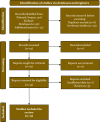Global prevalence and potential factors influencing willingness for renal transplantation in end-stage renal disease patients: A systematic review and meta- analysis
- PMID: 39816085
- PMCID: PMC11732001
- DOI: 10.52225/narra.v4i3.903
Global prevalence and potential factors influencing willingness for renal transplantation in end-stage renal disease patients: A systematic review and meta- analysis
Abstract
The prevalence of willingness to undergo renal transplantation and its potentially associated factors have been documented in multiple prior studies across different regions, yet certain findings are conflicting. The aim of this study was to determine the global prevalence of willingness for renal transplantation and identify its associated factors through meta-analysis methods. Databases such as Scopus, PubMed, and Embase were utilized for the search strategy, covering the period from April to May 2024. Data collection focused on gathering information regarding the prevalence and potential contributing factors of renal transplantation. Statistical analysis involved examining the cumulative prevalence of willingness for renal transplantation using single-arm meta- analysis. Factors associated with willingness for renal transplantation were analyzed using the Mantel-Haenszel test for categorical variables and the inverse variance method for numerical variables. A total of nine articles, covering 3935 patients with end-stage renal disease (ESRD) were included. The pooled estimates revealed that the overall prevalence of willingness to undergo renal transplantation among ESRD patients was 57% (95%CI: 0.46-0.67). Furthermore, we observed a higher likelihood of willingness among men and those of younger age, attainment of at least a bachelor's degree or higher in education, employment status, higher income levels, and a shorter duration of hemodialysis (<5 years). Our study has documented the global prevalence and potential associated factors of willingness to undergo renal transplantation, providing valuable insights for policymakers aiming to enhance the acceptance of renal transplantation.
Keywords: Renal transplantation; end-stage renal disease; predictors; prevalence; willingness.
© 2024 The Author(s).
Conflict of interest statement
All the authors declare that there are no conflicts of interest.
Figures



References
-
- Al Wakeel JS, Mitwalli AH, Al Mohaya S, et al. . Morbidity and mortality in ESRD patients on dialysis. Saudi J Kidney Dis Transpl 2002;13(4):473–477. - PubMed
-
- Elsharif ME. Mortality rate of patients with end stage renal disease on regular hemodialysis: A single center study. Saudi J Kidney Dis Transpl 2011;22(3):594–596. - PubMed
-
- Turgut F, Abdel-Rahman EM. Challenges associated with managing end-stage renal disease in extremely morbid obese patients: Case series and literature review. Nephron 2017;137(3):172–177. - PubMed
-
- Mazen M, Rifai A, Gunawan A. The association between albumin levels, platelet-to-albumin ratio, and the likelihood of peritonitis occurrence in individuals undergoing peritoneal dialysis. Deka in Medicine 2024;1(1):e887.
Publication types
MeSH terms
LinkOut - more resources
Full Text Sources
Medical
Miscellaneous
